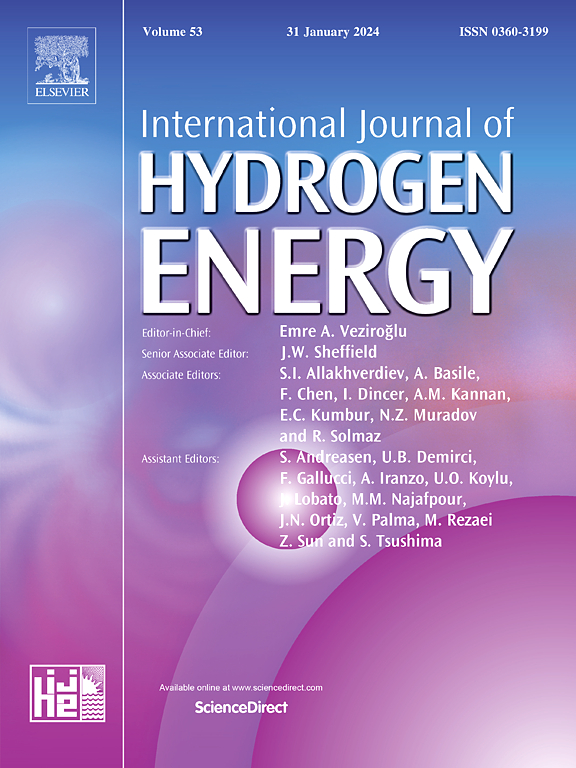ru修饰的NiFe2O4/NiO异质结用于高性能碱性析氢
IF 8.3
2区 工程技术
Q1 CHEMISTRY, PHYSICAL
引用次数: 0
摘要
Pt、Ir、Ru等贵金属是酸性环境下析氢反应(HER)的高效催化剂;然而,由于水解离的缓慢动力学,它们的效率在碱性环境中显著降低。掺杂和界面工程已成为提高水分解性能的有效途径。本文介绍了一种新型的花状钌异质结构催化剂(Ru-NiFe2O4/NiO),通过简单的水热法在泡沫镍(NF)上垂直生长,然后退火。改进后的催化剂具有电子结构调制、富含活性位点的层次化纳米片结构和定制的氢吸附特性等优点。结果表明,Ru-NiFe2O4/NiO表现出显著的HER活性,在电流密度为10和100 mA cm−2时,过电位分别仅为17 mV和78 mV, Tafel斜率低至37.98 mV dec−1,超过了20% Pt/C。利用Ru-NiFe2O4/NiO‖NiFe组装的碱性电解槽达到1.513 V的电池电压,并在10 mA cm−2的电流密度下保持稳定运行超过30小时,超过RuO2‖Pt/C基准(1.62 V)。本研究为异质结构工程和贵金属掺杂开发高效HER催化剂提供了一条有效途径。本文章由计算机程序翻译,如有差异,请以英文原文为准。
Ru-modified NiFe2O4/NiO heterojunction for high-performance alkaline hydrogen evolution
Precious metals like Pt, Ir, and Ru are highly efficient catalysts for the hydrogen evolution reaction (HER) in acidic environments; however, their efficiency significantly decreases in alkaline environments due to the slow kinetics of water dissociation. Doping and interface engineering have emerged as effective ways to improve water-splitting performance. This study introduces a novel Ru-doped flower-like heterostructure catalyst (Ru-NiFe2O4/NiO) vertically grown on nickel foam (NF) via a simple hydrothermal method followed by annealing. The improved catalyst derives advantages from electronic structure modulation, a hierarchical nanosheet architecture rich in active sites, and tailored hydrogen adsorption characteristics. As a result, Ru-NiFe2O4/NiO demonstrates remarkable HER activity, exhibiting overpotentials of merely 17 mV and 78 mV at current densities of 10 and 100 mA cm−2, respectively, alongside a low Tafel slope of 37.98 mV dec−1, surpassing that of commercial 20 % Pt/C. An assembled alkaline electrolyzer utilizing Ru-NiFe2O4/NiO‖NiFe achieves a cell voltage of 1.513 V and maintains stable operation for over 30 h at a current density of 10 mA cm−2, surpassing the RuO2‖Pt/C benchmark (1.62 V). This study presents an effective approach for the development of efficient HER catalysts through heterostructure engineering and noble metal doping.
求助全文
通过发布文献求助,成功后即可免费获取论文全文。
去求助
来源期刊

International Journal of Hydrogen Energy
工程技术-环境科学
CiteScore
13.50
自引率
25.00%
发文量
3502
审稿时长
60 days
期刊介绍:
The objective of the International Journal of Hydrogen Energy is to facilitate the exchange of new ideas, technological advancements, and research findings in the field of Hydrogen Energy among scientists and engineers worldwide. This journal showcases original research, both analytical and experimental, covering various aspects of Hydrogen Energy. These include production, storage, transmission, utilization, enabling technologies, environmental impact, economic considerations, and global perspectives on hydrogen and its carriers such as NH3, CH4, alcohols, etc.
The utilization aspect encompasses various methods such as thermochemical (combustion), photochemical, electrochemical (fuel cells), and nuclear conversion of hydrogen, hydrogen isotopes, and hydrogen carriers into thermal, mechanical, and electrical energies. The applications of these energies can be found in transportation (including aerospace), industrial, commercial, and residential sectors.
 求助内容:
求助内容: 应助结果提醒方式:
应助结果提醒方式:


